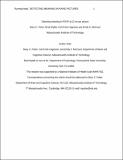| dc.contributor.author | Wyble, Brad | |
| dc.contributor.author | Potter, Mary C | |
| dc.contributor.author | Hagmann, Carl | |
| dc.contributor.author | McCourt, Emily Sarah | |
| dc.date.accessioned | 2017-02-24T22:26:27Z | |
| dc.date.available | 2017-02-24T22:26:27Z | |
| dc.date.issued | 2013-12 | |
| dc.identifier.issn | 1943-3921 | |
| dc.identifier.issn | 1943-393X | |
| dc.identifier.uri | http://hdl.handle.net/1721.1/107157 | |
| dc.description.abstract | The visual system is exquisitely adapted to the task of extracting conceptual information from visual input with every new eye fixation, three or four times a second. Here we assess the minimum viewing time needed for visual comprehension, using rapid serial visual presentation (RSVP) of a series of six or 12 pictures presented at between 13 and 80 ms per picture, with no interstimulus interval. Participants were to detect a picture specified by a name (e.g., smiling couple) that was given just before or immediately after the sequence. Detection improved with increasing duration and was better when the name was presented before the sequence, but performance was significantly above chance at all durations, whether the target was named before or only after the sequence. The results are consistent with feedforward models, in which an initial wave of neural activity through the ventral stream is sufficient to allow identification of a complex visual stimulus in a single forward pass. Although we discuss other explanations, the results suggest that neither reentrant processing from higher to lower levels nor advance information about the stimulus is necessary for the conscious detection of rapidly presented, complex visual information. | en_US |
| dc.description.sponsorship | National Institutes of Health (U.S.) (Grant No. MH47432) | en_US |
| dc.publisher | Springer US | en_US |
| dc.relation.isversionof | http://dx.doi.org/10.3758/s13414-013-0605-z | en_US |
| dc.rights | Creative Commons Attribution-Noncommercial-Share Alike | en_US |
| dc.rights.uri | http://creativecommons.org/licenses/by-nc-sa/4.0/ | en_US |
| dc.source | Springer US | en_US |
| dc.title | Detecting meaning in RSVP at 13 ms per picture | en_US |
| dc.type | Article | en_US |
| dc.identifier.citation | Potter, Mary C., Brad Wyble, Carl Erick Hagmann, and Emily S. McCourt. “Detecting Meaning in RSVP at 13 Ms Per Picture.” Attention, Perception, & Psychophysics 76, no. 2 (December 28, 2013): 270–279. | en_US |
| dc.contributor.department | Massachusetts Institute of Technology. Department of Brain and Cognitive Sciences | en_US |
| dc.contributor.mitauthor | Potter, Mary C | |
| dc.contributor.mitauthor | Hagmann, Carl | |
| dc.contributor.mitauthor | McCourt, Emily Sarah | |
| dc.relation.journal | Attention, Perception, & Psychophysics | en_US |
| dc.eprint.version | Author's final manuscript | en_US |
| dc.type.uri | http://purl.org/eprint/type/JournalArticle | en_US |
| eprint.status | http://purl.org/eprint/status/PeerReviewed | en_US |
| dc.date.updated | 2016-05-23T12:18:05Z | |
| dc.language.rfc3066 | en | |
| dc.rights.holder | Psychonomic Society, Inc. | |
| dspace.orderedauthors | Potter, Mary C.; Wyble, Brad; Hagmann, Carl Erick; McCourt, Emily S. | en_US |
| dspace.embargo.terms | N | en |
| dc.identifier.orcid | https://orcid.org/0000-0002-5781-756X | |
| mit.license | OPEN_ACCESS_POLICY | en_US |
